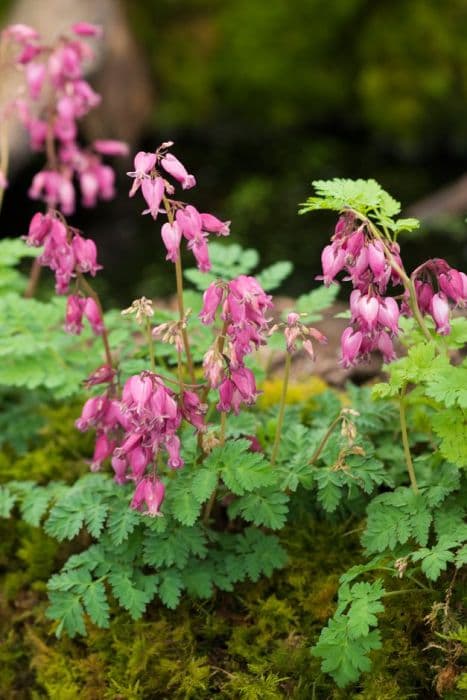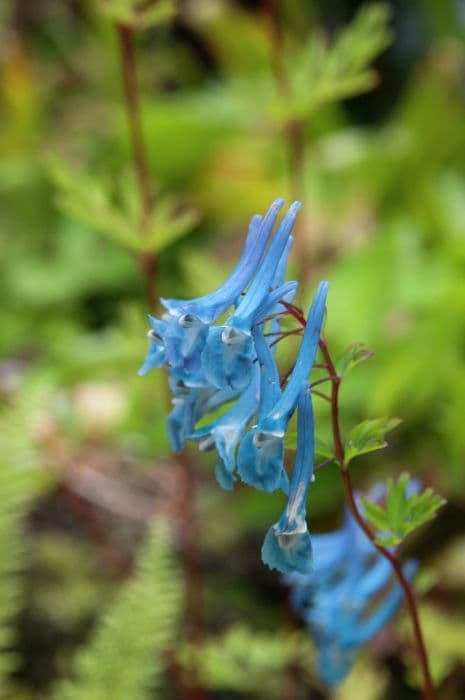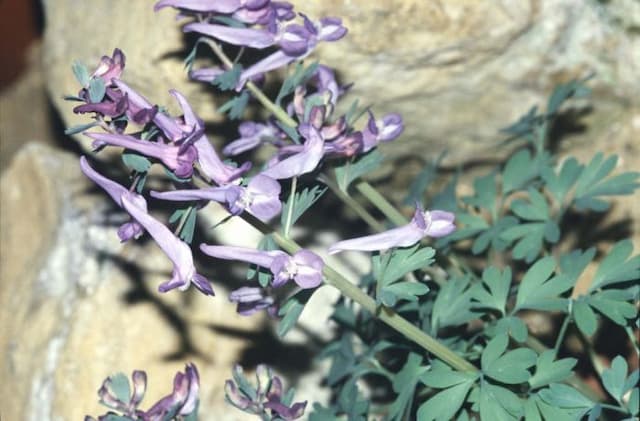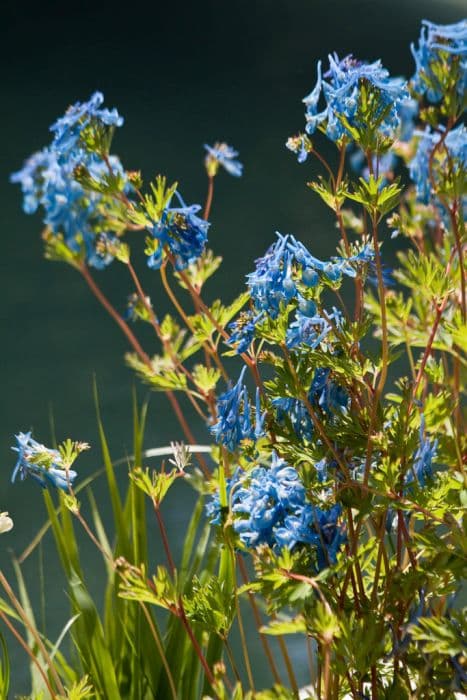Bleeding Heart Dicentra 'Luxuriant'

ABOUT
Dicentra 'Luxuriant', commonly known as the bleeding heart, is an elegant and attractive perennial plant. It boasts delicate, fern-like foliage that is a soft shade of green, creating a feathery backdrop for its distinctive flowers. The plant is adorned with charming heart-shaped flowers that dangle gracefully from arching stems. These blossoms have an outer layer of fuchsia or pink, while the inner petals often display a lighter, almost white hue, creating a look of a heart with a drop hanging at the bottom, which is characteristic of the bleeding heart's unique appearance. The blooms are arranged in a row along the stem, creating a striking display that can add a touch of romance to any garden setting. The overall aesthetic of Dicentra 'Luxuriant' is one of whimsy and allure, with the blooms and foliage combining to create a plant that is both eye-catching and soothing in its beauty.
About this plant
 Names
NamesFamily
Papaveraceae.
Synonyms
Bleeding Heart, Fringed Bleeding Heart.
Common names
Dicentra formosa 'Luxuriant'.
 Toxicity
ToxicityTo humans
Bleeding heart, which is the most common common name for Dicentra 'Luxuriant', contains isoquinoline alkaloids, which can be toxic to humans if ingested. The level of toxicity is generally considered to be low, but consuming parts of the plant can lead to symptoms such as vomiting, diarrhea, dizziness, and confusion. In severe cases, seizures and respiratory failure are possible. It is important to seek medical attention if ingestion occurs, especially in children, who are more sensitive to the toxic compounds.
To pets
Bleeding heart is also toxic to pets, including dogs and cats. The plant contains isoquinoline alkaloids that can lead to symptoms of poisoning if ingested. These symptoms may include drooling, nausea, vomiting, diarrhea, tremors, and in severe cases, seizures. Ingesting large amounts can be particularly dangerous and could potentially lead to respiratory distress or heart issues. It is advised to seek veterinary care promptly if you suspect your pet has ingested any part of a bleeding heart plant.
 Characteristics
CharacteristicsLife cycle
Perennials
Foliage type
Deciduous
Color of leaves
Green
Flower color
Pink
Height
1 foot (30 cm)
Spread
1-2 feet (30-60 cm)
Plant type
Herb
Hardiness zones
3
Native area
North America
Benefits
 General Benefits
General Benefits- Attracts pollinators: Dicentra 'Luxuriant' produces flowers that attract bees, butterflies, and other beneficial insects to the garden.
- Easy to grow: This plant is known for its hardiness and is relatively easy to care for, making it suitable for gardeners of all skill levels.
- Shade tolerance: It grows well in shaded areas where other flowering plants might struggle, adding color and interest to such spots.
- Long blooming period: The bleeding heart 'Luxuriant' variety offers a long flowering season, usually from late spring to early summer.
- Deer resistant: The plant is not a preferred choice for deer, reducing the likelihood of damage in areas where deer are common.
- Low maintenance: Once established, the bleeding heart requires minimal maintenance, making it a convenient option for busy gardeners.
- Beautiful foliage: In addition to its attractive flowers, the plant also has fern-like foliage that adds a unique texture to the garden landscape.
- Herbaceous perennial: As a perennial, Dicentra 'Luxuriant' will return each year, helping to build and maintain a consistent garden structure.
 Medical Properties
Medical PropertiesThis plant is not used for medical purposes.
 Air-purifying Qualities
Air-purifying QualitiesThis plant is not specifically known for air purifying qualities.
 Other Uses
Other Uses- Photography backdrop - The heart-shaped flowers of the Bleeding Heart plant make a beautiful and romantic backdrop for close-up photography, such as for wedding or engagement photos.
- Educational tool - Schools and botanical gardens may use the Bleeding Heart plant to teach students about unique flower structures and pollination mechanisms.
- Theme gardens - The Bleeding Heart can serve as a centerpiece in a themed garden, such as a 'Valentine's Garden' with red, pink, and white flowering plants.
- Flower pressing - The delicate blossoms of the Bleeding Heart can be pressed and used in crafts or to adorn handwritten letters for a vintage aesthetic.
- Artistic inspiration - Artists may use the Bleeding Heart plant as a subject for paintings, drawings, or sculpture due to its visually striking appearance.
- Holiday decor - Bleeding Heart's flowers can be incorporated into seasonal decorations, like creating heart-shaped motifs for Valentine’s Day.
- Color dye - Historically, some plants have been used to create natural dyes; however, it's not common for the Bleeding Heart but could be experimented with for its pink to red hues.
- Floral crafts - The flowers and foliage can be used in homemade wreaths or other floral crafts for springtime decor.
- Living gift - As a potted plant, the Bleeding Heart can make for a living, sustainable gift that symbolizes love and affection for the recipient.
- Motif in literature or poetry - Due to its unique shape, the Bleeding Heart may be referenced in literature or poetry as a symbol of love and passion.
Interesting Facts
 Feng Shui
Feng ShuiThe Bleeding Heart is not used in Feng Shui practice.
 Zodiac Sign Compitability
Zodiac Sign CompitabilityThe Bleeding Heart is not used in astrology practice.
 Plant Symbolism
Plant Symbolism- Love and romance: Dicentra 'Luxuriant', commonly known as Bleeding Heart, traditionally symbolizes deep emotions and romantic love due to its heart-shaped flowers with a drop at the bottom, which can evoke the image of a heart 'bleeding.'
- Compassion and empathy: The heart-like shape of the Bleeding Heart's flowers are also seen as symbols of compassion and empathy, suggesting an open heart and a willingness to feel another's pain.
- Grace and elegance: Bleeding Heart's arching stems and graceful flowers convey a sense of refinement and poise, making it a symbol of both grace and beauty in the language of flowers.
- Expressive emotions: Due to its dramatic appearance, the Bleeding Heart is often associated with the ability to openly express one's emotions, whether of joy or sorrow.
- Rejected love: In some interpretations, Bleeding Heart flowers can represent the pain of love not reciprocated, as the flower's appearance suggests a feeling of sadness and longing.
 Water
WaterBleeding heart should be watered regularly to maintain moisture, but take care not to overwater and allow the soil to become waterlogged. Typically, giving the plant about 1 gallon per week should be adequate; adjust based on temperature and rainfall, increasing in hot, dry conditions. Water directly at the base to avoid wetting the foliage, which can lead to disease. During the growing season in spring and summer, ensure consistent watering, but you can reduce frequency in the fall as the plant goes dormant.
 Light
LightBleeding heart thrives in partial shade to full shade conditions, especially in areas with cool summers. The best spot for this plant would be in a garden that receives morning sunlight and is shaded from the harsh afternoon sun. If the climate is cooler, bleeding hearts can tolerate more sunlight without scorching.
 Temperature
TemperatureBleeding heart prefers cool temperatures and is hardy in USDA zones 3 through 9. The ideal temperature range for growing bleeding heart is between 55°F and 75°F, ensuring the plant's vitality. It can survive minimum temperatures down into the low 20s°F for brief periods but prolonged exposure to temperatures below freezing can damage or kill the plant.
 Pruning
PruningBleeding heart benefits from pruning to remove dead or diseased foliage and to shape the plant. The best time to prune is in late fall or early spring before new growth begins. Deadheading spent flowers can encourage additional blooming but is generally not necessary. If the plant becomes too large or unruly, cut it back by up to one-third every few years to maintain its size and shape.
 Cleaning
CleaningAs needed
 Soil
SoilBleeding heart 'Luxuriant' thrives in moist, well-draining soil rich in organic matter with a pH of 6.0 to 7.0. For best results, mix loam, peat moss, and perlite in equal parts.
 Repotting
RepottingBleeding heart 'Luxuriant' does not need frequent repotting and can be done every 3-4 years or when it outgrows its container.
 Humidity & Misting
Humidity & MistingBleeding heart 'Luxuriant' prefers high humidity levels, around 40-50%, to mimic its natural woodland environment.
 Suitable locations
Suitable locationsIndoor
Place Bleeding heart 'Luxuriant' in bright, indirect light and keep soil moist.
Outdoor
Plant Bleeding heart 'Luxuriant' in partial shade and moist, fertile soil.
Hardiness zone
3-9 USDA
 Life cycle
Life cycleThe life cycle of Dicentra 'Luxuriant', commonly known as the fernleaf bleeding heart, begins with seed germination when temperature and soil conditions become favorable, typically in the spring. The seeds develop into small seedlings with characteristic fern-like foliage. As the plant matures, it forms a clump of delicate, divided leaves and begins to produce its distinct heart-shaped pink flowers which bloom prolifically in late spring to early summer. Following the flowering period, if pollinated, the flowers will develop into fruit capsules containing seeds for the next generation. In summer's heat, the fernleaf bleeding heart may go dormant, with the foliage dying back until cooler conditions return in fall or the subsequent spring. Each year, if the conditions are right, the plant will re-emerge from its root system, completing its perennial cycle.
 Propogation
PropogationPropogation time
Spring-Early Summer
The Bleeding Heart 'Luxuriant' is commonly propagated through division, typically in the spring or fall. To propagate by division, carefully dig up an established clump and gently separate the roots into smaller sections, each with several growth points or eyes. These sections should then be replanted at the same depth they were originally growing, spaced about a foot (approximately 30 centimeters) apart to allow enough room for growth. It is important to keep the newly planted divisions well-watered until they are established, and it is advisable to do this during cooler parts of the day to reduce stress on the plants. Mulching around the base can help retain moisture and provide a stable environment for the young divisions to thrive.









